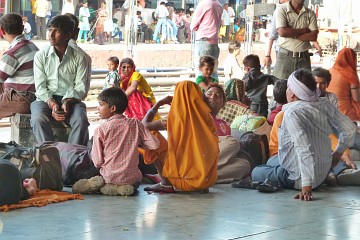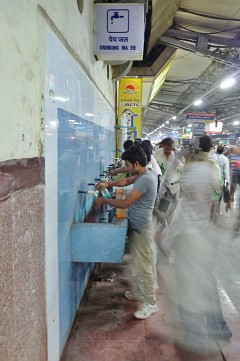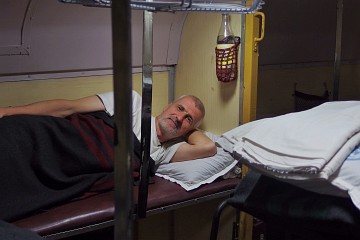Quintessential Indian Railways
(vero; updated 2016-April-20)
Besides the fact that Vero is a railway fan per se, we both have a particular relationship to Indian Railways. To us, they are an integral part of Indian travel and we love to hear that so special and recurring sound of a tooting train, it simply belongs to the country. As Vero explained in our planning page, it all starts when we are still home, one can get indeed really soaked up into the world of Indian Railways. The idea of a train running 4279 km in about 82 and a half hours is simply of another world and quite fascinating (or so we think)...
 When we are in country, we tend to use trains to cover long distances. We usually take overnight trains and if possible stick to sleeper class. First, it is uncredibly cheap and second, it is always good for meeting people and experiencing India at first hand. However, it is not all that good...
When we are in country, we tend to use trains to cover long distances. We usually take overnight trains and if possible stick to sleeper class. First, it is uncredibly cheap and second, it is always good for meeting people and experiencing India at first hand. However, it is not all that good...
First of all, seats/bunks do sell out VERY quickly, which means that, if you want a minimum of comfort (and we do), reserving a journey implies advance booking (the booking window starts 120 days before travel) which will impact spontaneity, something which we are always keen to preserve, this idea of being able to overthrow plans on a whim. Also, compared to our first visit to India, we have the feeling that travelling in reserved sleeper class has got tougher: there are simply not enough trains and seats for the amount of people travelling. Normally, only people with a reservation can occupy a bunk/seat, but very often, people without a reservation will try their luck by simply taking the first seat available: on long distance trains, some seats are only reserved for part of the journey, so it might turn out that they can occupy the bunk for a portion of the trip: better than nothing...
This means that it is not unusual to board a train and find one's seat/bunk already occupied: then a conversation begins where at the end you have to eject the person. Not always pleasant. Then the "ejected" people, simply stay around... squeeze at the foot of the lower bed, sleep on the floor between the seats, in the corridors. And when the train manager comes by and tells them to move out of the reserved car, they bribe him to be able to stay. Some managers will not accept the bribe, but most do, with the result that the whole can get quite uncomfortable and noisy, with people moving around, and if you have the bad luck of having a lower bunk, you end up sharing it with somebody taking over the space at your feet and more... To counter this, if possible, we always book upper or middle bunks. Upper is best as you are then in control of your space. This did not use to happen the first years we visited India, but we've experienced it quite often during our last trip in 2015.
 We have many memories of train journeys which are great to remember, once they are over: rushing from one platform to the other, trying to keep up with the station's announcements about when and where the train will alight, accumulating hours of delay (such an horrible train, a fellow passenger kept moaning on the Howrah-Varanasi Express), waiting for ages in the middle of nowhere, stepping over bodies in the middle of the night to get a pee...
We have many memories of train journeys which are great to remember, once they are over: rushing from one platform to the other, trying to keep up with the station's announcements about when and where the train will alight, accumulating hours of delay (such an horrible train, a fellow passenger kept moaning on the Howrah-Varanasi Express), waiting for ages in the middle of nowhere, stepping over bodies in the middle of the night to get a pee...
Travelling by day is different: on long distances, passengers come and go, there is a constant agitation and traffic of vendors, with passengers chatting, eating, drinking chai. Things can also get very tight and squeezed, so you never know in advance, a journey can be everything from a very pleasant ride to a completely frustrating and exhausting experience.
 In spite of all this, we still prefer travelling 2nd or sleeper class, instead of retreating in the comfort of restricted AC compartments. We booked our first 3A trip in 2015, meaning one bunk/one person with pillow, sheets and AC and only people with a reservation allowed in the car: was OK, but we do not yet feel old enough for making an habit of it ;-). To get to grips with the different travel classes and find an answer to most questions you might have about train travel in India, we highly recommend the website of the Man in Seat 61.
In spite of all this, we still prefer travelling 2nd or sleeper class, instead of retreating in the comfort of restricted AC compartments. We booked our first 3A trip in 2015, meaning one bunk/one person with pillow, sheets and AC and only people with a reservation allowed in the car: was OK, but we do not yet feel old enough for making an habit of it ;-). To get to grips with the different travel classes and find an answer to most questions you might have about train travel in India, we highly recommend the website of the Man in Seat 61.
But Indian Railways are more than just travelling: stations are often a good bet to find cheap and tasty joints for a meal or a snack. They are the perfect place for a toilet break and most important: we can always refill our water bottles at their drinking water fountains.
At the end of a long and hot day of sightseeing, we like to get a cold bottle of soda or cola from a shop (2 liters!), find a relatively quiet spot and simply indulge in one of our most cherished pleasure while on the road: people watching. Impossible to get bored, we can spend hours observing the trains, the people waiting, embarking, disembarking. Whole families having a meal, discussing, sleeping on the platform, children playing, you name it, a feast for the eyes, pure bliss!
Want to read more? Go back to Karnataka 2013 or go on to In Buddha's Footsteps or go up to Blog
$ updated from: Blog.htxt Mon 28 Apr 2025 14:55:30 trvl2 — Copyright © 2025 Vero and Thomas Lauer unless otherwise stated | All rights reserved $



